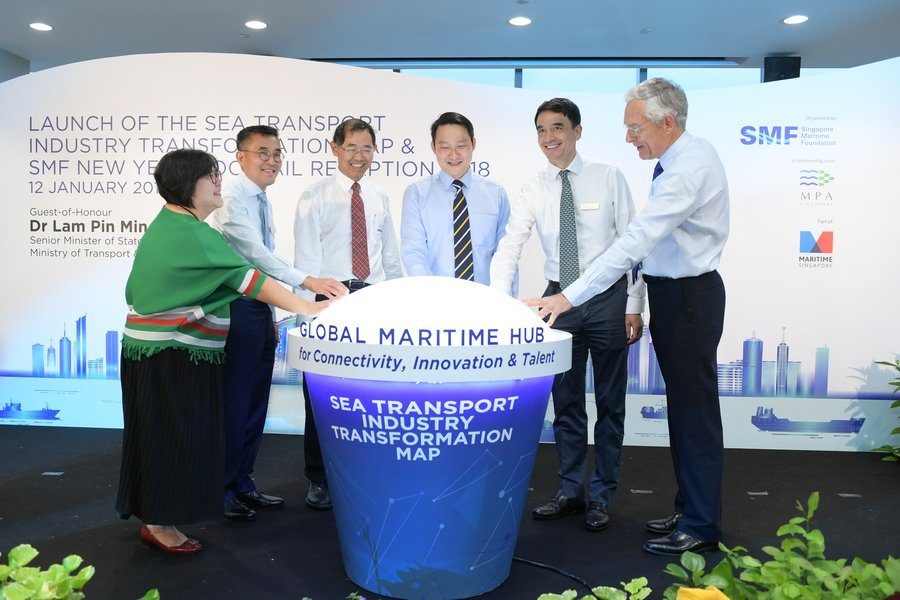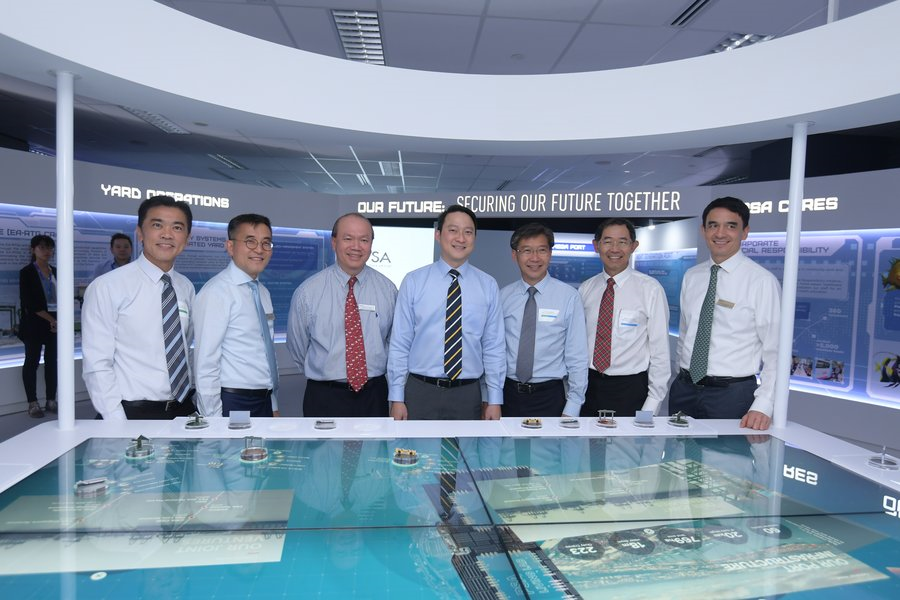Sea Transport Industry Transformation Map to Drive Singapore’s Vision to be a Global Maritime Hub for Connectivity, Innovation and Talent
Published 12 Jan 2018
12 January 2018
Grow sector’s value-add by S$4.5 billion and create over 5,000 good jobs by 2025
Dr Lam Pin Min, Senior Minister of State (SMS) for Ministry of Transport and Ministry of Health, launched the Sea Transport Industry Transformation Map (ITM) at the annual Singapore Maritime Foundation New Year Cocktail Reception this evening.
2. Developed by the Maritime and Port Authority of Singapore (MPA) in partnership with the industry, unions and other government agencies, the Sea Transport ITM builds on MPA’s strategic long term plans to develop Singapore’s next-generation port and strengthen our international maritime centre (IMC). Specific initiatives have been laid out under the Sea Transport ITM to catalyse innovation, drive productivity improvements, as well as enhance the skills of the maritime workforce. The aim is to grow the sector’s value-add by S$4.5 billion and create more than 5,000 good jobs by 2025.
3. At the ITM launch, five Memorandums of Understanding (MOUs) were signed between MPA and various tripartite partners to underscore the collective commitment of stakeholders to drive innovation, productivity and human capital development in the transformation of Maritime Singapore. (Please refer to Annex A to E for more details).
Maritime Singapore – A Key Pillar of Singapore’s Economy
4. The maritime industry contributes 7% of Singapore’s Gross Domestic Product (GDP) and employs over 170,000 people. In 2017, spurred by improvements in global trade growth and the repositioning of major shipping alliances, Singapore’s container throughput grew by 9% to 33.7 million TEUs, from 30.9 million TEUs in 2016. (Please refer to Annex F for Port of Singapore’s Performance in 2017.)
Promoting Connectivity, Innovation and Talent
Building up a Well-Connected and Vibrant IMC cluster
5. Singapore will continue to strengthen its IMC to enhance its long-term competiveness and value proposition to shipping companies and maritime service providers. We will also continue to build up our connectivity to maritime clusters overseas to harness the extensive network effects of such linkages. This will help us remain a leading and vital node in the global maritime network.
6. Companies like CMA-CGM, COSCO and the merged Ocean Network Express (ONE), have grown their corporate presence in Singapore. For instance, CMA-CGM has established its Asia regional office, its global Navigation and Port Operations Centre and, more recently, its Asian digital activity hub in Singapore. It has also entered into a container terminal joint venture with PSA. ONE has chosen Singapore as its global liner headquarters; COSCO has expanded its joint-venture with PSA for a third berth at Pasir Panjang Terminal. These activities in turn have drawn in other maritime services providers such as insurance, broking, financial services, classification societies, P&I Clubs, legal and arbitration.
7. To sustain Singapore’s competitive advantage and strengthen port connectivity, MPA is also working with the industry to develop the port eco-system in adjacent sectors, such as logistics and e-commerce.
Enhancing Productivity and Innovation
8. To forge ahead, Singapore is investing in new port capabilities that will capitalise on emerging technologies arising from Industry 4.0. Tuas Port will be an efficient and intelligent port that harnesses data analytics to optimise operations such as just-in-time vessel arrivals and the Maritime Single Window for quicker port clearance. Under the MPA-PSA Port Technology Research and Development Programme (PTRDP), MPA and PSA will jointly step up R&D and capability development in the areas of digitalisation, connected community systems as well as automation and robotics. A fleet of 30 automated guided vehicles (AGVs) have been deployed in a trial with automated yard cranes and quay cranes in the Pasir Panjang Terminal. Deployment of such automated systems will be scaled up in the Tuas Port. MPA also renewed the MOU with Jurong Port on “Next Generation Multipurpose Port Programme” in 2017 to support efforts to digitalise multipurpose port operations. The Jurong Port Living Lab launched last October will provide opportunities for Jurong Port to experiment with innovative ideas and deploy leading edge technologies to enhance productivity.
9. Innovation will remain key as Singapore develops future capabilities and solutions built on emerging technologies such as autonomous systems, robotics, data analytics and artificial intelligence. To drive this next phase of growth, MPA will support companies to embark on innovation and productivity-driven growth by putting in place an enabling environment and infrastructure. The MPA Living Lab will offer technology developers and industry partners a rich maritime data platform and a real operating environment at the port to co-develop and pilot innovative solutions. MPA will also work with stakeholders to promote greater sharing of data and information within the industry. In addition, new research centres of excellence at NTU and NUS will deepen Singapore’s maritime R&D capabilities and accelerate technology transfers and spin-offs to the industry.
10. Singapore can also leverage digital solutions to enhance operational efficiencies and provide greater value to its customers. For instance, the use of Electronic Certificates (E-Certs) onboard Singapore-flagged vessels since 2016 has helped reduce the administrative burden and costs associated with traditional paper certificates. MPA, Singapore Customs and the Singapore Shipping Association will therefore be jointly looking at the digitalisation of trade and maritime documentation in the industry to co-develop cross-sector solutions, such as the development and adoption of electronic bills of lading (e-BL), which would facilitate more efficient trade flows through Singapore and bring about benefits to the wider supply chain ecosystem. (Please refer to Annex B for more details).
Creating New Jobs, Developing a Future-Ready Workforce
11. As the maritime industry transforms and grows, more than 5,000 good jobs will be created in the next decade. Those in more traditional job roles will undergo skill upgrading as jobs evolve with increasing automation and digitalisation.
12. To help our workers achieve their potential, new maritime programmes, such as the Earn and Learn Programmes for seafarers and port operations executives launched by MPA in 2016, will continue to be developed to meet the needs of the industry. Maritime companies can also tap on the Maritime Cluster Fund (MCF) to up-skill their employees not only in specialised areas, but also in more general areas like data analytics, cyber security, as well as in soft skills, like communication and executive leadership.
13. MPA will continue to help Singaporeans take advantage of the many opportunities in the maritime industry, and build a future-ready workforce with relevant skills and a global mindset.
Transformation Driven by Tripartite Partnership
14. SMS Dr Lam said, “The strategies and targets set out by the ITM are undoubtedly ambitious. But with the strong partnership from the industry, the unions and government agencies such as SkillsFuture Singapore and Workforce Singapore, I am confident that we can achieve our vision for Singapore to be a Global Maritime Hub for Connectivity, Innovation and Talent.”
15. Mr Esben Poulsson, President of the Singapore Shipping Association (SSA), said, “It is heartening that in the evolving maritime landscape, the Singapore government is galvanising the industry to embrace emerging technologies and relook their systems and processes to achieve greater efficiencies and optimisation. The development of the Sea Transport transformation map is another testimony of the strong alignment between the government and industry in Singapore that has been and will continue to be the key to the success of Maritime Singapore.”
16. Ms Mary Liew, President of the National Trades Union Congress, said, “The maritime industry is a diverse and dynamic one that provides many opportunities for our working people to pursue meaningful careers. With the industry changing at such a rapid pace, it is critical that workers constantly re-skill and up-skill themselves to remain relevant and future-ready. The Labour Movement is committed to working closely with our tripartite partners to ensure our workers have the right skills to support growth in the maritime industry, as well as deliver concrete action plans to realise the benefits of the Industry Transformation Map for our working people.”
<End of release>

Dr Lam Pin Min, Senior Minister of State (SMS), Ministry of Transport and Ministry of Health, officially launched the Sea Transport Industry Transformation Map (ITM) at the Singapore Maritime Foundation (SMF) New Year Cocktail Reception. From left to right - Ms Jessie Yeo, Maritime Cluster Lead, National Trade Union Congress; Mr Andrew Tan, Chief Executive of MPA; Mr Niam Chiang Meng, Chairman of MPA; SMS Dr Lam Pin Min; Mr Andreas Sohmen-Pao, Chairman of SMF; and Mr Esben Poulsson, President of Singapore Shipping Association.

Dr Lam Pin Min, SMS, Ministry of Transport and Ministry of Health, at the PSA ‘Intelligent Port of the Future’ Exhibition showcasing the transformation of port operations through technology and innovation.
